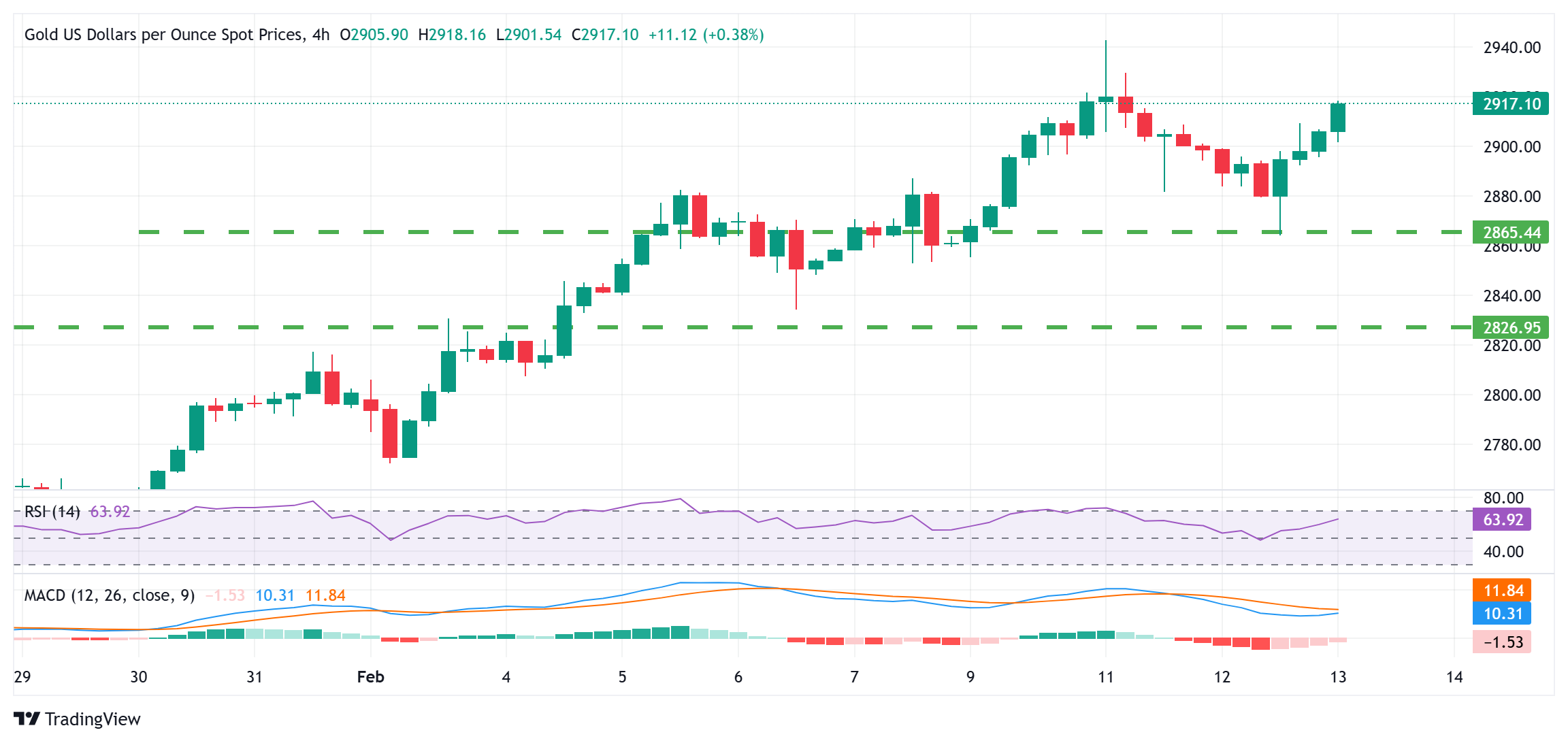Gold price remains close to all-time high amid Trump-related anxieties, softer USD

Gold price attracts buyers for the second straight day amid a combination of supportive factors.
Concerns about Trump’s trade tariff and a modest USD weakness underpin the XAU/USD pair.
Reduced Fed rate cut bets warrant some caution before positioning for a further positive move.
Gold price (XAU/USD) trades with a mild positive bias during the Asian session on Thursday and looks to build on the previous day's goodish bounce from the $2,864 area touched in reaction to hotter US consumer inflation figures. US President Donald Trump's new tariffs on commodity imports sparked fears about a global trade war, which continue to act as a tailwind for the safe-haven bullion. Furthermore, a modest US Dollar (USD) downtick turns out to be another factor underpinning demand for the commodity.
Meanwhile, signs of still sticky inflation in the US suggest that the Federal Reserve (Fed) will stick to its hawkish stance and hold interest rates steady for an extended period. This led to the overnight spike in the US Treasury bond yields, which should limit any meaningful USD losses. Apart from this, a generally positive risk tone might contribute to capping any further gains for the non-yielding Gold price. Traders now look to the release of the US Producer Price Index (PPI) for some impetus later during the North American session.
Gold price continues to attract haven flows amid global trade war fears
The initial market reaction to the latest US consumer inflation figures turned out to be short-lived amid worries over US President Donald Trump's trade tariffs, which continue to benefit the safe-haven Gold price.
Trump signed executive orders on Monday to impose 25% tariffs on steel and aluminum imports into the US and also promised broader reciprocal tariffs to match the levies other governments charge on US products.
The US Bureau of Labor Statistics reported on Wednesday that the headline US Consumer Price Index rose 0.5% in January – the most since August 2023 – and the yearly rate climbed to 3% from 2.9% in December.
Meanwhile, the core CPI, which excludes food and energy prices, nudged up by 0.4% on a monthly basis and jumped 3.3% from a year ago compared to 3.1% expected, pointing to underlying inflationary pressures.
Fed Chair Jerome Powell told US lawmakers that the battle with rising prices wasn't finished yet, which meant that any further interest rate cuts would have to wait until it was clear inflation would return to the 2% target.
The Atlanta Fed President noted that the labor market is performing incredibly well and the GDP is more resilient than expected, though the latest inflation numbers show careful monitoring is still needed.
Market participants were quick to react and now see just one Fed rate cut by the end of this year, assisting the yield on the benchmark 10-year US government bond to register its biggest one-day rise since December.
The US Dollar (USD), however, struggles to attract any meaningful buyers and languishes near the lower end of its weekly range touched on Wednesday, further lending support to the USD-denominated commodity.
Thursday's US economic docket features the release of the Producer Price Index and the usual Weekly Initial Jobless Claims, which might influence the USD and provide some impetus to the XAU/USD pair.
Gold price could face stiff resistance at higher levels amid still-overbought daily RSI
From a technical perspective, the daily Relative Strength Index (RSI) remains in the overbought territory and warrants some caution before positioning for any further gains. Bulls are more likely to take a brief pause near the $2,942-2,943 area, or the all-time peak touched on Tuesday, which should now act as an immediate strong barrier for the Gold price.
On the flip side, weakness back below the $2,900 round figure might expose the overnight swing low, around the $2,864 area. Some follow-through selling could make the Gold price vulnerable to accelerate the corrective pullback towards intermediate support near the $2,834-2,832 region en route to the $2,800 mark.
* The content presented above, whether from a third party or not, is considered as general advice only. This article should not be construed as containing investment advice, investment recommendations, an offer of or solicitation for any transactions in financial instruments.



